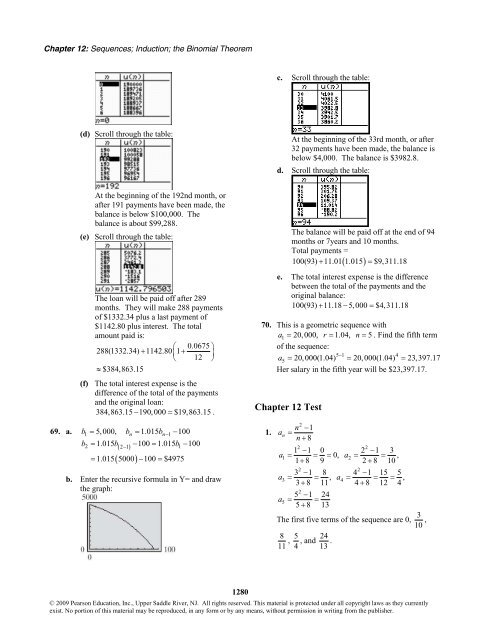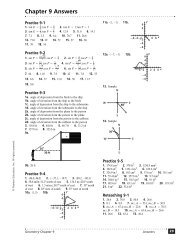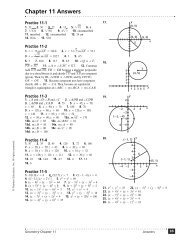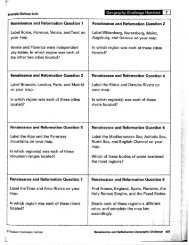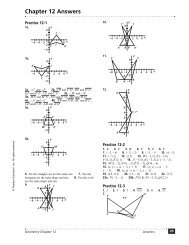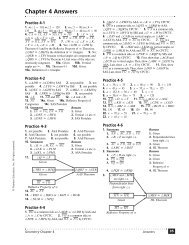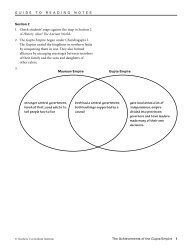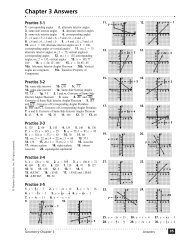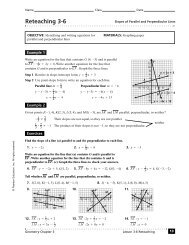Chapter 12 Sequences; Induction; the Binomial Theorem
Chapter 12 Sequences; Induction; the Binomial Theorem
Chapter 12 Sequences; Induction; the Binomial Theorem
You also want an ePaper? Increase the reach of your titles
YUMPU automatically turns print PDFs into web optimized ePapers that Google loves.
<strong>Chapter</strong> <strong>12</strong>: <strong>Sequences</strong>; <strong>Induction</strong>; <strong>the</strong> <strong>Binomial</strong> <strong>Theorem</strong><br />
c. Scroll through <strong>the</strong> table:<br />
(d) Scroll through <strong>the</strong> table:<br />
At <strong>the</strong> beginning of <strong>the</strong> 33rd month, or after<br />
32 payments have been made, <strong>the</strong> balance is<br />
below $4,000. The balance is $3982.8.<br />
d. Scroll through <strong>the</strong> table:<br />
At <strong>the</strong> beginning of <strong>the</strong> 192nd month, or<br />
after 191 payments have been made, <strong>the</strong><br />
balance is below $100,000. The<br />
balance is about $99,288.<br />
(e) Scroll through <strong>the</strong> table:<br />
The loan will be paid off after 289<br />
months. They will make 288 payments<br />
of $1332.34 plus a last payment of<br />
$1142.80 plus interest. The total<br />
amount paid is:<br />
⎛ 0.0675 ⎞<br />
288(1332.34) + 1142.80⎜1+<br />
⎟<br />
⎝ <strong>12</strong> ⎠<br />
≈ $384,863.15<br />
(f) The total interest expense is <strong>the</strong><br />
difference of <strong>the</strong> total of <strong>the</strong> payments<br />
and <strong>the</strong> original loan:<br />
384,863.15 − 190,000 = $19,863.15 .<br />
69. a. b1 = 5,000, bn<br />
= 1.015bn<br />
− 1−<br />
100<br />
b2 = 1.015b( 2−1)<br />
− 100 = 1.015b1−100<br />
= 1.015 5000 − 100 = $4975<br />
( )<br />
b. Enter <strong>the</strong> recursive formula in Y= and draw<br />
<strong>the</strong> graph:<br />
The balance will be paid off at <strong>the</strong> end of 94<br />
months or 7years and 10 months.<br />
Total payments =<br />
100(93) + 11.01 1.015 = $9,311.18<br />
( )<br />
e. The total interest expense is <strong>the</strong> difference<br />
between <strong>the</strong> total of <strong>the</strong> payments and <strong>the</strong><br />
original balance:<br />
100(93) + 11.18 − 5,000 = $4,311.18<br />
70. This is a geometric sequence with<br />
a1 = 20,000, r = 1.04, n = 5 . Find <strong>the</strong> fifth term<br />
of <strong>the</strong> sequence:<br />
5−1 4<br />
a 5 = 20,000(1.04) = 20,000(1.04) = 23,397.17<br />
Her salary in <strong>the</strong> fifth year will be $23,397.17.<br />
<strong>Chapter</strong> <strong>12</strong> Test<br />
1.<br />
2<br />
n −1<br />
an<br />
=<br />
n + 8<br />
2 2<br />
1 −1 0 2 −1 3<br />
a1 = = = 0, a2<br />
= = ,<br />
1+ 8 9 2+<br />
8 10<br />
2 2<br />
3 −1 8 4 −1 15 5<br />
a3 = = , a4<br />
= = = ,<br />
3+ 8 11 4+<br />
8 <strong>12</strong> 4<br />
2<br />
5 −1 24<br />
a5<br />
= =<br />
5+<br />
8 13<br />
The first five terms of <strong>the</strong> sequence are 0, 3<br />
10 ,<br />
8<br />
11 , 5 24<br />
, and<br />
4 13 .<br />
<strong>12</strong>80<br />
© 2009 Pearson Education, Inc., Upper Saddle River, NJ. All rights reserved. This material is protected under all copyright laws as <strong>the</strong>y currently<br />
exist. No portion of this material may be reproduced, in any form or by any means, without permission in writing from <strong>the</strong> publisher.


